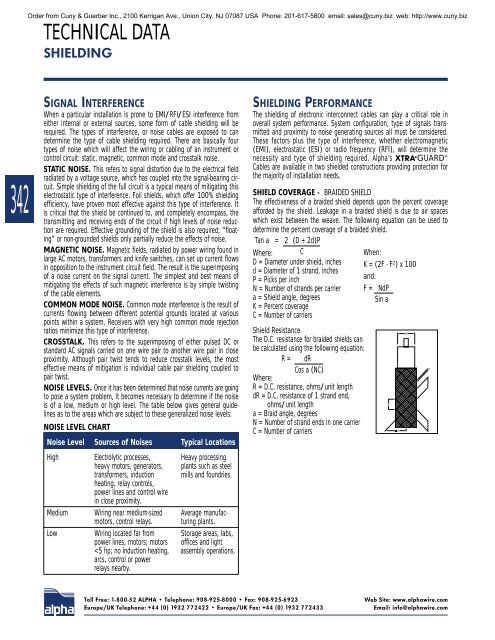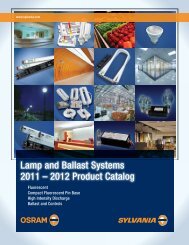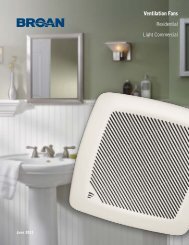- Page 1 and 2:
Order from Cuny & Guerber Inc., 210
- Page 3 and 4:
Order from Cuny & Guerber Inc., 210
- Page 5 and 6:
Order from Cuny & Guerber Inc., 210
- Page 7 and 8:
Order from Cuny & Guerber Inc., 210
- Page 9 and 10:
Order from Cuny & Guerber Inc., 210
- Page 11 and 12:
Order from Cuny & Guerber Inc., 210
- Page 13 and 14:
Order from Cuny & Guerber Inc., 210
- Page 15 and 16:
Insulation Temp. Voltage Specificat
- Page 17 and 18:
Order from Cuny & Guerber Inc., 210
- Page 19 and 20:
◆ABBREVIATIONS TO CONDUCTOR INSUL
- Page 21 and 22:
Order from Cuny & Guerber Inc., 210
- Page 23 and 24:
Order from Cuny & Guerber Inc., 210
- Page 25 and 26:
Order from Cuny & Guerber Inc., 210
- Page 27 and 28:
Order from Cuny & Guerber Inc., 210
- Page 29 and 30:
In today’s world of sophisticated
- Page 31 and 32:
XTRA•GUARD ® 2 XTRA•GUARD ® O
- Page 33 and 34:
XTRA•GUARD ® 1 EXTRA-PREMIUM GRA
- Page 35 and 36:
XTRA•GUARD ® 1 MULTICONDUCTOR, U
- Page 37 and 38:
XTRA•GUARD ® 1 MULTICONDUCTOR, U
- Page 39 and 40:
XTRA•GUARD ® 1 MULTICONDUCTOR, F
- Page 41 and 42:
XTRA•GUARD ® 1 MULTICONDUCTOR, F
- Page 43 and 44:
XTRA•GUARD ® 1 MULTICONDUCTOR, F
- Page 45 and 46:
XTRA•GUARD ® 1 MULTICONDUCTOR, S
- Page 47 and 48:
XTRA•GUARD ® 1 MULTICONDUCTOR, S
- Page 49 and 50:
XTRA•GUARD ® 1 MULTIPAIR, UNSHIE
- Page 51 and 52:
XTRA•GUARD ® 1 MULTIPAIR, SUPRAS
- Page 53 and 54:
XTRA•GUARD ® 2 INDUSTRIAL STRENG
- Page 55 and 56:
Order from Cuny & Guerber Inc., 210
- Page 57 and 58:
Order from Cuny & Guerber Inc., 210
- Page 59 and 60:
Order from Cuny & Guerber Inc., 210
- Page 61 and 62:
Order from Cuny & Guerber Inc., 210
- Page 63 and 64:
Order from Cuny & Guerber Inc., 210
- Page 65 and 66:
XTRA•GUARD ® 3 EXTRA-DURABLE OUT
- Page 67 and 68:
Order from Cuny & Guerber Inc., 210
- Page 69 and 70:
Order from Cuny & Guerber Inc., 210
- Page 71 and 72:
Order from Cuny & Guerber Inc., 210
- Page 73 and 74:
XTRA•GUARD ® 4 EXTRA-PROTECTION,
- Page 75 and 76:
XTRA•GUARD ® 4 MULTICONDUCTOR, U
- Page 77 and 78:
XTRA•GUARD ® 4 MULTICONDUCTOR, F
- Page 79 and 80:
XTRA•GUARD ® 4 MULTICONDUCTOR, F
- Page 81 and 82:
XTRA•GUARD ® 4 MULTICONDUCTOR, S
- Page 83 and 84:
XTRA•GUARD ® 4 MULTIPAIR, UNSHIE
- Page 85 and 86:
XTRA•GUARD ® 4 MULTIPAIR, FOIL S
- Page 87 and 88:
XTRA•GUARD ® 4 MULTIPAIR, SUPRAS
- Page 89 and 90:
XTRA•GUARD ® 5 EXTRA HIGH-TEMPER
- Page 91 and 92:
Order from Cuny & Guerber Inc., 210
- Page 93 and 94:
Order from Cuny & Guerber Inc., 210
- Page 95 and 96:
Order from Cuny & Guerber Inc., 210
- Page 97 and 98:
Order from Cuny & Guerber Inc., 210
- Page 99 and 100:
Order from Cuny & Guerber Inc., 210
- Page 101 and 102:
CHOOSE XTRA•GUARD STANDARD-FLEX C
- Page 103 and 104:
UL AWM STYLE 2587 CSA AWM II A/B FT
- Page 105 and 106:
CHOOSE XTRA •GUARD HIGH-FLEX MINI
- Page 107 and 108:
UL AWM STYLE 20234 CSA AWM II A/B F
- Page 109 and 110:
XTRA•GUARD ® Flexible Cables FLE
- Page 111 and 112:
Alpha Wire INDUSTRIAL SERIES TECHNO
- Page 113 and 114:
Order from Cuny & Guerber Inc., 210
- Page 115 and 116:
Order UL from TYPE Cuny TC-ER & 600
- Page 117 and 118:
Order from Cuny & Guerber Inc., 210
- Page 119 and 120:
Order from Cuny & Guerber Inc., 210
- Page 121 and 122:
Order from Cuny & Guerber Inc., 210
- Page 123 and 124:
Order from Cuny & Guerber Inc., 210
- Page 125 and 126:
Order from Cuny & Guerber Inc., 210
- Page 127 and 128:
Order from Cuny & Guerber Inc., 210
- Page 129 and 130:
Order from Cuny & Guerber Inc., 210
- Page 131 and 132:
Order from Cuny & Guerber Inc., 210
- Page 133 and 134:
Order from Cuny & Guerber Inc., 210
- Page 135 and 136:
Order from Cuny & Guerber Inc., 210
- Page 137 and 138:
Order from Cuny & Guerber Inc., 210
- Page 139 and 140:
Order from Cuny & Guerber Inc., 210
- Page 141 and 142:
Order from Cuny & Guerber Inc., 210
- Page 143 and 144:
Order from Cuny & Guerber Inc., 210
- Page 145 and 146:
Order from Cuny & Guerber Inc., 210
- Page 147 and 148:
Order from Cuny & Guerber Inc., 210
- Page 149 and 150:
Order from Cuny & Guerber Inc., 210
- Page 151 and 152:
Order from Cuny & Guerber Inc., 210
- Page 153 and 154:
Order from Cuny & Guerber Inc., 210
- Page 155 and 156:
Order from Cuny & Guerber Inc., 210
- Page 157 and 158:
WIRE MANAGEMENT PRODUCTS WITH DISTI
- Page 159 and 160:
CHARACTERISTICS OPERATING TEMPERATU
- Page 161 and 162:
CHARACTERISTICS OPERATING TEMPERATU
- Page 163 and 164:
CHOOSE GRP NF FOR: ■ Frayless Cut
- Page 165 and 166:
Order from Cuny & Guerber Inc., 210
- Page 167 and 168:
SPIRAL WRAP TUBING APPLICATIONS:
- Page 169 and 170:
WIRE MANAGEMENT PRODUCTS TINNED COP
- Page 171 and 172:
CHARACTERISTICS PHYSICAL PROPERTIES
- Page 173 and 174:
CHARACTERISTICS COLOR DESCRIPTION:
- Page 175 and 176:
Order from Cuny & Guerber Inc., 210
- Page 177 and 178:
Order from Cuny & Guerber Inc., 210
- Page 179 and 180:
† Also meets MIL-W-76B Type LW *S
- Page 181 and 182:
MIL-W-16878E TYPE B: 105°C, 600 VO
- Page 183 and 184:
AVAILABILITY ■ 100 ft (30,5m), 50
- Page 185 and 186:
STRANDED CONDUCTOR HOOK-UP WIRE TFE
- Page 187 and 188:
HOOK-UP WIRE TFE TEFLON ® INSULATI
- Page 189 and 190:
Order from Cuny & Guerber Inc., 210
- Page 191 and 192:
UL TYPE CM, UL AWM 2509, 2576, CSA
- Page 193 and 194:
CHARACTERISTICS OPERATING TEMPERATU
- Page 195 and 196:
COMMUNICATION & CONTROL MULTICONDUC
- Page 197 and 198:
UL TYPE CM, UL AWM 2092, 2093, 2094
- Page 199 and 200:
COMMUNICATION & CONTROL MULTICONDUC
- Page 201 and 202:
COMMUNICATION & CONTROL MULTICONDUC
- Page 203 and 204:
MIL-W-16878D TYPE B/N 600 VOLT CHAR
- Page 205 and 206:
APPLICATIONS ■ Ideal for Crowded
- Page 207 and 208:
COMMUNICATION & CONTROL MULTICONDUC
- Page 209 and 210:
COMMUNICATION & CONTROL MULTICONDUC
- Page 211 and 212:
Order from Cuny & Guerber Inc., 210
- Page 213 and 214:
COMMUNICATION & CONTROL MULTICONDUC
- Page 215 and 216:
Order from Cuny & Guerber Inc., 210
- Page 217 and 218:
COMMUNICATION & CONTROL MULTICONDUC
- Page 219 and 220:
Order from Cuny & Guerber Inc., 210
- Page 221 and 222:
Order from Cuny & Guerber Inc., 210
- Page 223 and 224:
UL TYPE CM UL AWM 2464, CSA CMG FT4
- Page 225 and 226:
UL TYPE CM UL AWM 2464, 2576, CSA C
- Page 227 and 228:
UL TYPE CM UL AWM 2919, CSA CMG FT4
- Page 229 and 230:
Order from Cuny & Guerber Inc., 210
- Page 231 and 232:
Order from Cuny & Guerber Inc., 210
- Page 233 and 234:
CHARACTERISTICS OPERATING TEMPERATU
- Page 235 and 236:
Order from Cuny & Guerber Inc., 210
- Page 237 and 238:
UL TYPE CM UL AWM 2464, CSA CMG FT4
- Page 239 and 240:
UL TYPE CM UL AWM 2493, CSA CMG FT4
- Page 241 and 242:
Order from Cuny & Guerber Inc., 210
- Page 243 and 244:
COMM.& CONTROL MULTIPAIR, INDIVIDUA
- Page 245 and 246:
Order from Cuny & Guerber Inc., 210
- Page 247 and 248:
Order from Cuny & Guerber Inc., 210
- Page 249 and 250:
Order from Cuny & Guerber Inc., 210
- Page 251 and 252:
UL TYPE CM UL AWM 2092, 2093, 2094
- Page 253 and 254:
Order from Cuny & Guerber Inc., 210
- Page 255 and 256:
BUILDING ZONE FACILITIES MANAGEMENT
- Page 257 and 258:
BUILDING ZONE FACILITIES MANAGEMENT
- Page 259 and 260:
BUILDING ZONE FACILITIES MANAGEMENT
- Page 261 and 262:
BUILDING ZONE FACILITIES MANAGEMENT
- Page 263 and 264:
Order from Cuny & Guerber Inc., 210
- Page 265 and 266:
NON-PLENUM LOCAL AREA NETWORK COAXI
- Page 267 and 268:
NON-PLENUM LOCAL AREA NETWORK COAXI
- Page 269 and 270:
LOCAL AREA NETWORK COAXIAL CABLES O
- Page 271 and 272:
PLENUM LOCAL AREA NETWORK COAXIAL C
- Page 273 and 274:
NON-PLENUM LOCAL AREA NETWORK TWINA
- Page 275 and 276:
PLENUM AND NON-PLENUM LOCAL AREA NE
- Page 277 and 278:
LOCAL AREA NETWORK ETHERNET COAXIAL
- Page 279 and 280:
PLENUM AND NON-PLENUM Alpha Part No
- Page 281 and 282:
Order from Cuny & Guerber Inc., 210
- Page 283 and 284:
Order from Cuny & Guerber Inc., 210
- Page 285 and 286:
Order from Cuny & Guerber Inc., 210
- Page 287 and 288:
A VARIETY OF COAXIAL PRODUCTS COAXI
- Page 289 and 290:
COAXIAL CABLE SYSTEMS COAXIAL CABLE
- Page 291 and 292:
COAXIAL CABLE SYSTEMS COAXIAL CABLE
- Page 293 and 294:
Order from Cuny & Guerber Inc., 210
- Page 295 and 296:
Order from Cuny & Guerber Inc., 210
- Page 297 and 298:
Order from Cuny & Guerber Inc., 210
- Page 299 and 300:
CORDS AND ELECTRICAL CORDS AND CORD
- Page 301 and 302: Order from Cuny & Guerber Inc., 210
- Page 303 and 304: Order from Cuny & Guerber Inc., 210
- Page 305 and 306: Order from Cuny & Guerber Inc., 210
- Page 307 and 308: Order from Cuny & Guerber Inc., 210
- Page 309 and 310: Order from Cuny & Guerber Inc., 210
- Page 311 and 312: INTERNATIONAL CORD APPLICATIONS:
- Page 313 and 314: Order from Cuny & Guerber Inc., 210
- Page 315 and 316: Order from Cuny & Guerber Inc., 210
- Page 317 and 318: RETRACTILE CORD APPLICATIONS: ■ I
- Page 319 and 320: Order from Cuny & Guerber Inc., 210
- Page 321 and 322: Order from Cuny & Guerber Inc., 210
- Page 323 and 324: UNSHIELDED CONTROL CABLE APPLICATIO
- Page 325 and 326: WELDING CABLE APPLICATIONS: ■ On
- Page 327 and 328: PORTABLE POWER CABLE APPLICATIONS:
- Page 329 and 330: Order from Cuny & Guerber Inc., 210
- Page 331 and 332: INSTRUMENTATION CABLE OVERALL SHIEL
- Page 333 and 334: Order from Cuny & Guerber Inc., 210
- Page 335 and 336: UL TYPE TC 90°C 600 VOLT CHARACTER
- Page 337 and 338: Order from Cuny & Guerber Inc., 210
- Page 339 and 340: THERMOCOUPLE WIRE AND CABLE DUPLEX
- Page 341 and 342: Order from Cuny & Guerber Inc., 210
- Page 343 and 344: Order from Cuny & Guerber Inc., 210
- Page 345 and 346: FLAT CABLE COLOR-CODED FLAT CABLE 0
- Page 347 and 348: FLAT CABLE COLOR-CODED, TWIST-TO-FL
- Page 349 and 350: Order from Cuny & Guerber Inc., 210
- Page 351: TECHNICAL DATA TECHNICAL INFORMATIO
- Page 355 and 356: Order from Cuny & Guerber Inc., 210
- Page 357 and 358: Order from Cuny & Guerber Inc., 210
- Page 359 and 360: Order from Cuny & Guerber Inc., 210
- Page 361 and 362: Order from Cuny & Guerber Inc., 210
- Page 363 and 364: Order from Cuny & Guerber Inc., 210
- Page 365 and 366: Order from Cuny & Guerber Inc., 210
- Page 367 and 368: Order from Cuny & Guerber Inc., 210
- Page 369 and 370: Order from Cuny & Guerber Inc., 210
- Page 371 and 372: Order from Cuny & Guerber Inc., 210
- Page 373 and 374: Order from Cuny & Guerber Inc., 210
- Page 375 and 376: Order from Cuny & Guerber Inc., 210
- Page 377 and 378: TECHNICAL DATA Alpha Wire INDUSTRIA
- Page 379 and 380: Order from Cuny & Guerber Inc., 210
- Page 381 and 382: Order from Cuny & Guerber Inc., 210
- Page 383 and 384: Order from Cuny & Guerber Inc., 210
- Page 385 and 386: Order from Cuny & Guerber Inc., 210
- Page 387 and 388: Order from Cuny & Guerber Inc., 210
- Page 389 and 390: Order from Cuny & Guerber Inc., 210
- Page 391 and 392: Order from Cuny & Guerber Inc., 210
- Page 393 and 394: Order from Cuny & Guerber Inc., 210
- Page 395 and 396: Order from Cuny & Guerber Inc., 210
- Page 397 and 398: Order from Cuny & Guerber Inc., 210
- Page 399 and 400: Order from Cuny & Guerber Inc., 210
- Page 401 and 402: Order from Cuny & Guerber Inc., 210
- Page 403 and 404:
Order from Cuny & Guerber Inc., 210
- Page 405 and 406:
Order from Cuny & Guerber Inc., 210
- Page 407 and 408:
Order from Cuny & Guerber Inc., 210
- Page 409 and 410:
Order from Cuny & Guerber Inc., 210
- Page 411 and 412:
Order from Cuny & Guerber Inc., 210
- Page 413 and 414:
Order from Cuny & Guerber Inc., 210
- Page 415 and 416:
CONDUCTORS No. of Conductors: No. o
- Page 417 and 418:
Order from Cuny & Guerber Inc., 210





